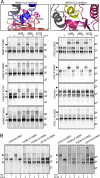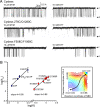Phenylalanine-508 mediates a cytoplasmic-membrane domain contact in the CFTR 3D structure crucial to assembly and channel function
- PMID: 18305154
- PMCID: PMC2265173
- DOI: 10.1073/pnas.0800254105
Phenylalanine-508 mediates a cytoplasmic-membrane domain contact in the CFTR 3D structure crucial to assembly and channel function
Abstract
Deletion of phenylalanine-508 (Phe-508) from the N-terminal nucleotide-binding domain (NBD1) of the cystic fibrosis transmembrane conductance regulator (CFTR), a member of the ATP-binding cassette (ABC) transporter family, disrupts both its folding and function and causes most cystic fibrosis. Most mutant nascent chains do not pass quality control in the ER, and those that do remain thermally unstable, only partially functional, and are rapidly endocytosed and degraded. Although the lack of the Phe-508 peptide backbone diminishes the NBD1 folding yield, the absence of the aromatic side chain is primarily responsible for defective CFTR assembly and channel gating. However, the site of interdomain contact by the side chain is unknown as is the high-resolution 3D structure of the complete protein. Here we present a 3D structure of CFTR, constructed by molecular modeling and supported biochemically, in which Phe-508 mediates a tertiary interaction between the surface of NBD1 and a cytoplasmic loop (CL4) in the C-terminal membrane-spanning domain (MSD2). This crucial cytoplasmic membrane interface, which is dynamically involved in regulation of channel gating, explains the known sensitivity of CFTR assembly to many disease-associated mutations in CL4 as well as NBD1 and provides a sharply focused target for small molecules to treat CF. In addition to identifying a key intramolecular site to be repaired therapeutically, our findings advance understanding of CFTR structure and function and provide a platform for focused biochemical studies of other features of this unique ABC ion channel.
Conflict of interest statement
The authors declare no conflict of interest.
Figures




References
-
- Quinton PM. Cystic fibrosis: Lessons from the sweat gland. Physiology. 2007;22:212–225. - PubMed
-
- Davis PB. Cystic fibrosis since 1938. Am J Respir Crit Care Med. 2006;173:475–482. - PubMed
-
- Bear CE, et al. Purification and functional reconstitution of the cystic fibrosis transmembrane conductance regulator (CFTR). Cell. 1992;68:809–818. - PubMed
Publication types
MeSH terms
Substances
Grants and funding
LinkOut - more resources
Full Text Sources
Other Literature Sources

